Benefits of single-leg exercises for the prevention of injuries in young tennis players
Introduction
The increased speed of the game in junior tennis has been accompanied by an increase in mechanical stress, most notably on lower limbs, with loads of 1.5 to 2.7 times the body weight on the knee during a change of direction (Kibler & Safran, 2000). In modern play, the ability to decelerate quickly has become as essential a factor as the ability to accelerate and is based on qualities of dynamic balance, eccentric strength, power and reactive strength (Kovacs et al., 2008).
Single-leg exercises have often been identified as a means of rehabilitation after a lower limb injury, but their effectiveness has also been demonstrated for prophylaxis purposes since they improve static and dynamic balance (Paterno et al., 2004; Mandelbaum et al., 2005). In combination with other types of training, such as plyometric training (Hewett, 2006), these exercises are reported to have an indirect impact on the ability to perform (Zech et al., 2010), as well as a direct impact in sports like figure skating where postural control is essential (Kovacs et al., 2004). In tennis, Barber-Westin et al. (2010) used this type of training as a tool to assess neuromuscular ability through single-leg hop tests with qualitative video analysis of landing and calculation of the symmetry index – obtained by dividing the mean distance hopped of the right leg by the mean distance hopped of the left leg, and then multiplying the result by 100 –, the value of which should be 85% or greater. Furthermore, studies have shown the relationship between balance and the risk of injury to the lower limbs in athletes (McGuine et al., 2000; Holm, 2004), as well as the correlation between muscular strength and postural control (Horlings et al., 2008).
Because they strengthen the gluteus medius and the lateral stabilising muscles of the hip, single-leg exercises contribute to the protection of the knee and the foot by preventing a lower limb collapse from the weight of the body, which would result in a series of stresses on the joints. The single-leg squat appears to be the most beneficial form of exercise to recruit these muscles (Ayotte et al., 2007). The possibilities offered by single-leg exercises are interesting since slight variations in the position of the free segments and in the execution of movements have an impact on the difficulty level of the exercises and make it possible to match the demands of tennis as closely as possible: combination of rotational movements (groundstrokes) and overhead movements (service and smash). The shifts in the centre of gravity related to body position changes will increase the activation levels of the stabilising muscles of the trunk (Hasegawa, 2004).
Therefore, it appears necessary to set up a neuromuscular training programme aimed at improving the stability of the lower limbs through squats, jumps, landings and rotations challenging the body’s balance. The integration of such exercises in a warm-up routine will help develop proprioception (unconscious perception of joint position under both static and dynamic conditions). The prescribed exercises can be general, tennis-oriented or tennis-specific exercises.
General Exercises :
1) 2 major single-leg bending exercises should be used: the squat (Figure 1) and the forward lunge with back leg at 45-degree angle (Figure 2); the set-up of these exercises should allow for increasing difficulty.
 (A)
(A)  (B)
(B)
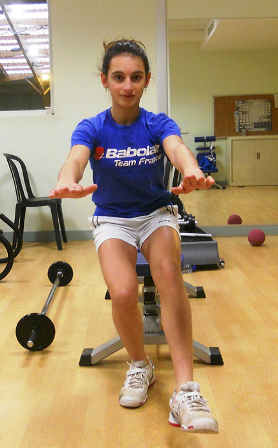 (C)
(C)
Figure 1 – Single-leg bending/extension with increasing difficulty: (A) in the air, (B) resting against a wall with a ball and (C) with the requirement to control the body weight throughout the movement.
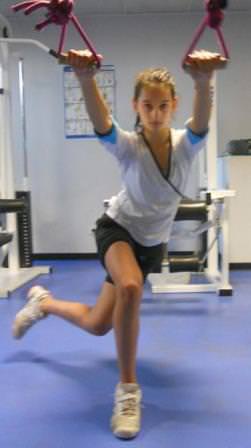 (A)
(A) 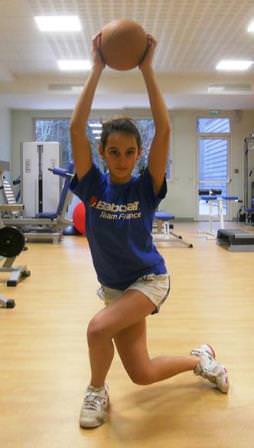 (B)
(B) 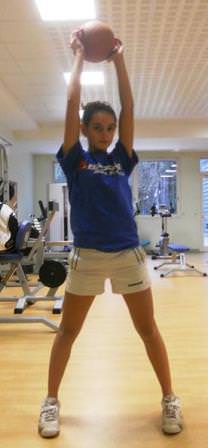 (C)
(C)
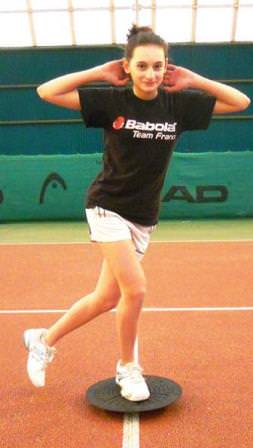 (D)
(D) 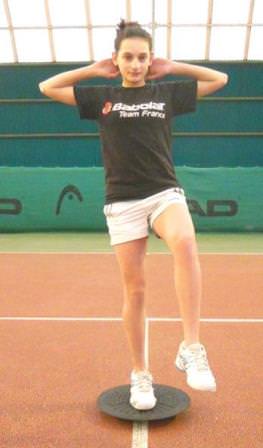 (E)
(E)
Figure 2 – Forward lunge with back leg at 45-degree angle for greater recruitment of the gluteus medius with increasing difficulty: (A) in the air, (B and C) with the back foot planted on the ground and a medicine-ball held with straight arms over the head, (D) with the requirement to control the body weight throughout the movement on a balance board. During the extension, the hips must return to a frontal position (C) with possibility of lifting the knee of the free leg to create axial imbalance (E).
2) Multi-directional single- or two-leg drives with controlled single-leg landing: dot drill, ladder drill, compass drill, skipping rope with varied movements. During these exercises, special attention should be paid to the execution of the landing, i.e. sufficient distance between the feet and neutral alignment (no valgus movement), flexion of the knees and hips in a controlled downward movement (45 to 90 degrees).
Tennis Oriented Exercises:
On a single leg, alternate ball and medicine-ball throws with rotation movement on a stable and then unstable surface (Figure 3).
 (A) and (B)
(A) and (B) 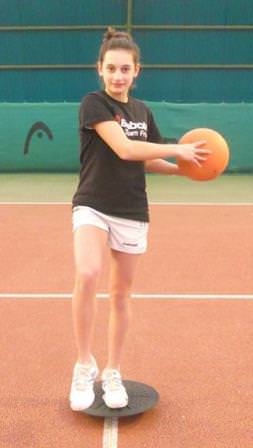 (C)
(C)
Figure 3 – Trunk rotation with a medicine-ball performed on an unstable board: (A) stabilisation phase, (B) external rotation to simulate the backswing phase and (C) internal rotation to simulate the hitting phase.
Tennis Specific Exercises:
Single-leg hitting movements on an unstable surface (Figure 4) or single-leg ball striking after a movement, which can be followed by a vertical jump and a controlled landing on the same leg.
It is also worth noting that these tennis-oriented and tennis-specific exercises also enhance functional core strength since they require a high level of trunk stabilisation for a better control of the body’s balance which is challenged by the quick rotation of the trunk (Ikeda et al., 2009).
 (A)
(A)  (B)
(B)  (C)
(C)
 (D)
(D)
Figure 4 – Single-leg forehand and backhand shadowing on a balance board: (A and C) backswing phase, (B and D) hitting and follow-through phases.
Conclusion:
Throughout the tennis player’s development, postural control improvement should be an essential component of each training session. A neuromuscular training routine can be incorporated to all warm-up phases of tennis sessions or be part of integrated physical training sessions. Because they are easy to use, single-leg exercises should be closely monitored throughout the season and the difficulty level and specificity of exercises should be adapted accordingly.
«Benefits of single-leg exercises for the prevention of injuries in young tennis athletes» - ITF Coaching and Sport Science Review 2013. 61(21):9-11
